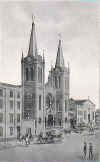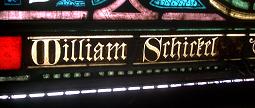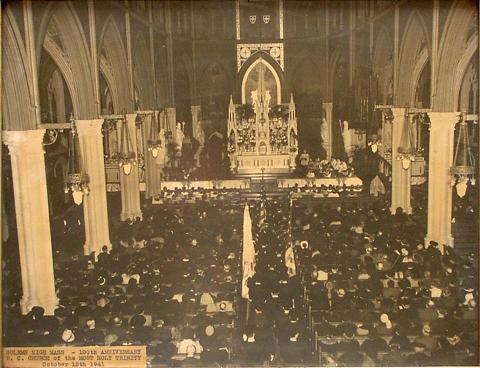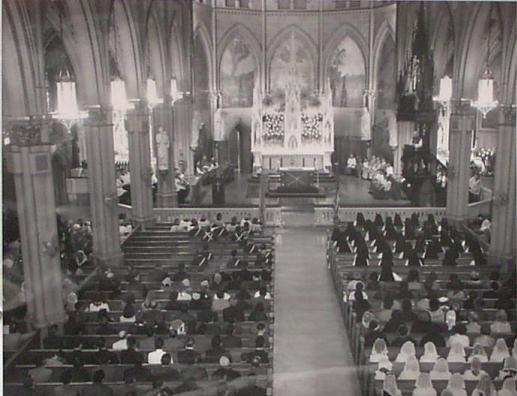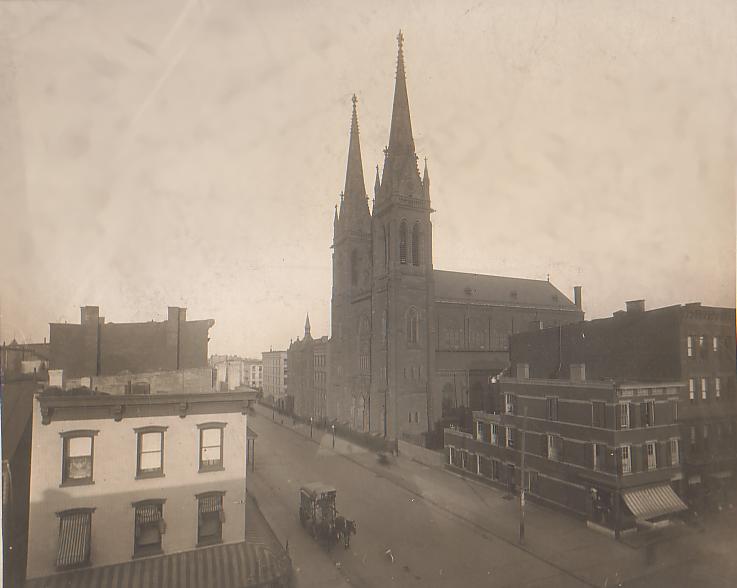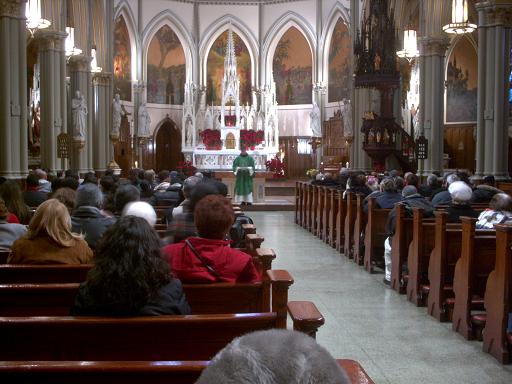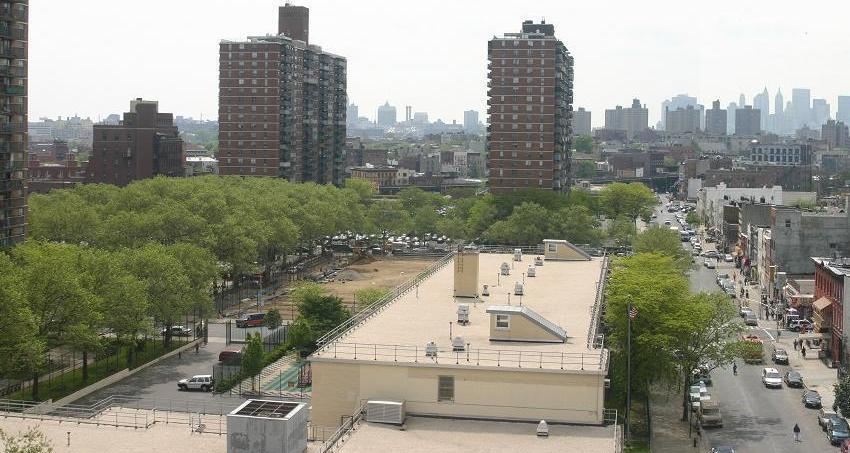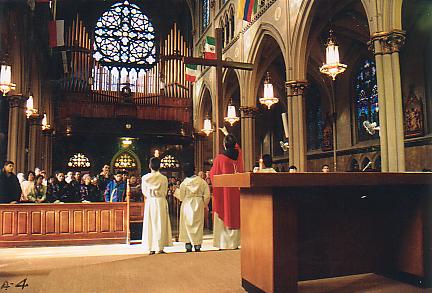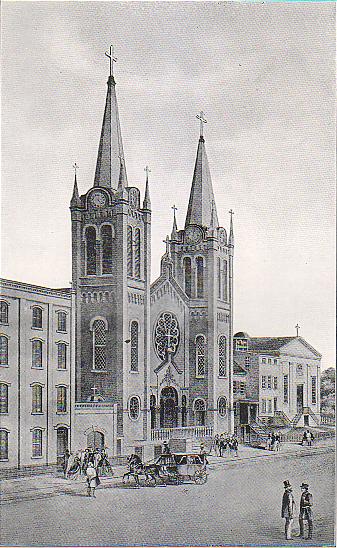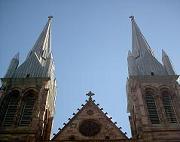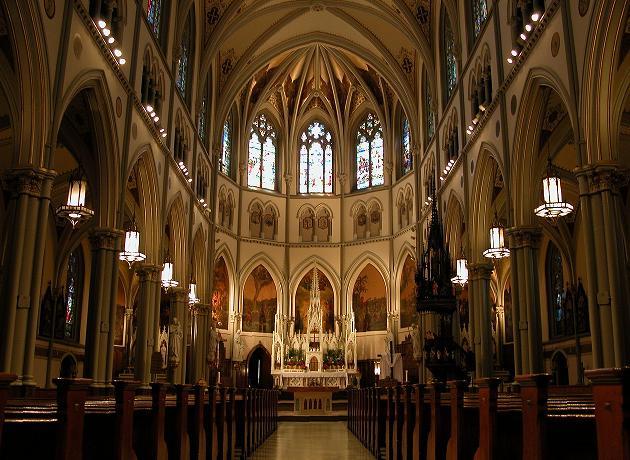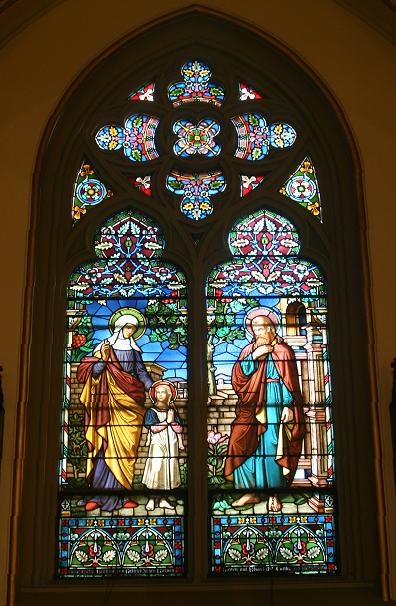|
To the right is a photo taken of Most Holy Trinity in 1916. Notice
the horse-drawn wagon on Montrose Avenue.
Below is an excerpt from the booklet printed during the one-hundredth
anniversary of the parish.
More information and excerpts from other sources will be added to this
page in the future.
From:
1841–1941: Centennial
Celebration of The Most Holy Trinity Church, Brooklyn, New York.
(October 12th to 16th, 1941): 3-21.
Historical Sketch
Few parishes, up to the present, in this famous city of churches, have had
the glorious distinction of completing one hundred years of remarkable
achievement. Certainly no national parish in this diocese has, as yet,
tasted the unbounded joy of a Century of Progress. ‘Tis only natural,
therefore, that we feel an honest pride to be the first German
parish—the Mother German Church, from which so many different
congregations have sprung—to achieve this enviable goal. We take an
honest pride, too, in being able to pen a chronological sketch of
heroic, successful spiritual as well as material effort, so
characteristically manifested by both priests and parishioners
throughout these hundred years.
The interesting annals of Most Holy Trinity find their inception in the
humble, obscure town of Mals in the Austrian Tirol, where on December
26, 1785, John Stephen Raffeiner, who was destined to be the founder
pastor of this famous parish, was born of pious, well-to-do parents. At
an early age, he manifested an eager desire to enter the priest hood; To
encourage and foster this noble ambition, his overjoyed parents
willingly sent him to a Benedictine monastery near Innsbruck, where he
began his training for his later work. in Rome, whither he had gone to
complete his studies, he found his lofty ideals rudely frustrated by the
closing of all religious institutions through the Napoleonic Wars in
1809. This interruption diverted his attention to the study of medicine,
which degree he received on May 4, 1813. Volunteering for military
service in the Austrian Army, his progress was so rapid that by 1815 he
stood at the head of his profession. After the cessation of the wars and
after some advanced studies at the University of Berlin, he became a
very successful, wealthy practitioner in the Austrian Tirol and
Switzerland.
His youthful ambition, however, once more seized him and laying aside
his established practice, he completed his theological studies in the
diocesan seminary in Brixon, South Tirol, where on May 1, 1825, at the
age of forty, he was ordained to the sacred priesthood. His first
sacerdotal assignment was as pastor and chaplain of a Tyrolese hospital
where for seven years he ministered both physically and spiritually to
those in his charge.
The lamentable dearth of priests among the constantly increasing number of
German immigrants in America occasioned a passionate appeal from Bishop
Fenwick of Cincinnati for volunteers to keep alive the ardent faith of
these good people. Eagerly did Father Raffeiner offer himself for this
service and after receiving episcopal permission, he set out for
Cincinnati—a destination he never reached, for on arriving in New York,
January 1, 1833, his strong personality so impressed Bishop Dubois that
the new missioner, after much persuasion, was induced to make this
vicinity the field of his priestly labors.
For seven years Father Raffeiner was actively engaged in establishing St.
Nicholas parish, the oldest German church in the diocese of New York.
During his medical practice, he had amassed a considerable fortune,
which he now freely used in promoting and preserving the faith in this
vicinity. Seeing a sizable German colony east of the Bowery, the
energetic man rented a carpenter shop on Delancey Street, where services
were temporarily conducted. He later leased a former meeting house of
the Ana-Baptists at Delancey and Pitt Streets, where the first
congregation of German Catholics was formally begun. The ever-increasing
number of parishioners made it imperative to seek a permanent structure,
for which purpose a number of lots were purchased on Second St., between
Avenue A and First Avenue, from John Jacob Astor. At a cost of some
$10,000, a brick building was erected on this site and dedicated to St.
Nicholas Bishop of Myra, on Easter Sunday,1836.
The burning zeal of this strong man did not, however, permit him to
confine his indefatigable efforts to local activity. Realizing that many
German Catholics were living in other outlying sections of the
Northeastern coast of America, despite the inconveniences of travel in
those early days, he journeyed to New Jersey, to Albany, to Utica, to
Rochester, yea, even to Boston, where the establishment of Holy Trinity
parish is ascribed to his noble efforts. In these far-reaching places he
revived a dormant yet firm faith in a good people, who according to his
own testimony had not seen nor heard a priest talking their language for
twenty-five years.
Upon his return from a visit to his native land in 1841, he petitioned his
Bishop to relieve him of his charge at St. Nicholas to minister more
fruitfully and effectively in a newly established, growing German colony
across the East River. Permission being granted, Father Raffeiner came
in the summer of 1841 to settle in Williamsburg to start the first
German Catholic church in this diocese.
His first administrative act was to purchase, mostly from his own
finances, part of a farm from Abraham Meserole — a property, lying
mid-way between Bushwick and the ferry to New York. Before a suitable
edifice could be erected, temporary quarters were found in a frame
building at 133 Montrose Avenue — a house which is still standing
opposite the present church. The cornerstone of the first church was
laid on July 9, 1841, by Archbishop Hughes of New York; the completed
frame structure, costing about $3,000 and situated on a hill, surrounded
too by a parochial cemetery, was dedicated by the same Prelate on
October 10, 1841. The first administration of Sacraments in this new
edifice were: Baptism: Jacob Fessler, September 19, 1841; Burial: Salome
Zimmer, November 15, 1841; Matrimony: Peter Schuler and Margaret Glanz,
February 7, 1 842. The basement of the church served this pioneer priest
as rectory and living quarters. Previously, he had lived with a family
by the name of Schnatterbeck on Union Avehue: the new place served him
till the erection of a rectory in August, 1844, at a cost of $1,200.00.
The most interesting detailed account of Father Raffeiner’s order of day
at that time is minutely pictured in a letter, written to his native
land by Rev. Adalbert Inama, pastor of Salina, N.Y., who visited Most
Holy Trinity parish in 1843. Because of its descriptive character, we
take the liberty of here publishing its translation:
“New York, March 13, 1843. — Raffeiner is in Williamsburg on Long
Island, about half an hour from here. I knew him by name only. I found
him in the basement of the church that he had built himself, lying near
the fire in his frame room in patriarchal simplicity.”
“Williamsburg, May 15, 1843. — Since the 21st inst. I have been living at
Father Raffeiner’s church in Williamsburg, which is separated from New
York by a small arm of the sea. I shall stay here until Raffeiner’s
return. Before closing I want to tell you something of Williamsburg and
the founder of this mission, our good countryman Raffeiner. While
Brooklyn has now some 50,000 inhabitants, there are only about 15,000 in
Williamsburg. But it is growing rapidly. Here a quarter of a mile from
the shore Raffeiner, some three years ago, laid the foundation for a
German Catholic church, which was blessed on October 10, 1841. The
foundation is of stone, the upper building of wood, built in such a way,
that it can be enlarged by a half of its length. In the basement of the
church is his parsonage, sacristy and school. Close by is the cemetery
and a large garden. The ground and building cost him some $4,000. All
this he paid partly by his own, savings, partly by credit loans, all of
which, excepting $500, is now paid. When this is also paid, the parish
will have a church free of debt, a very rare thing here, but a very
great blessing. The support of priest and church comes from pew rent and
collections which, the parish being very small (only about 70 families),
are such as would satisfy only a man like Raffeiner. Under such
conditions strict economy becomes a necessity, and only impassioned
calumny could raise the charge of avarice. Raffeiner enjoys the esteem
of all the priests around here, not only the Germans but also the Irish.
He is also greatly esteemed by his bishop who calls him the Patriarch of
the German Missionaries.
There is good reason to expect that within two years the German Catholic
parish will count much over 1,000 souls. Within the ten weeks of my stay
here, twenty new houses have been built by Catholics. When the corner
stone was laid there, there was only one Catholic house, now there are
some fifty. In a short time the parish will be able to have its own
school. In the matter of religious instruction, Raffeiner is doing all
he possibly can at his advanced age and under the circumstances. Three
times a week in the evening he gathers the young for cathechism class at
seven o’clock, as they must work during the day. All know how to attend
in time especially the day singing exercises.
Generally the young people here, especially the young married people, are
very good and of a holy, pious and edifying conduct. I speak from
experience. As the parish is not large, there is little work during the
week. Still something is always to be done. Thus, I hear confessions
nearly every day and how edifying it is to have communicants at nearly
every Mass. The confessions are usually somewhat long, as the people
have a holy thirst for instruction and consolation and fully open their
hearts. Wednesday and Friday evenings at seven o’clock I teach
catechism. Then every evening from eight to nine o’clock I have
instructions for young men 18 years old, preparatory for the first
reception of the Sacraments. Sunday is always a big confession day and
there is a good deal of other work all day. From five to eight o’clock
in the morning confessions are heard, after that, the early Mass. Then
the people come bringing their children and asking for all kinds of
advice. At ten o’clock there is the High Mass, the service lasting till
about twelve o’clock. After that till two o’clock one gets a little
rest. Then come Christian Doctrine, Vespers, Litanies and Benediction,
all of which lasts about two hours. Private conversations with
individual parties on different pastoral matters fill the rest of the
day, so that you stop talking only with evening. The forenoon and
afternoon service as here established by the custom and piety of the
people, I must confess, is most edifying, The High Mass is a choral
mass, all in Latin, sung in quartet by beautiful and youthful voices,
lasting fully an hour. People here seem to be accustomed to long
sermons; one can hardly be long enough. Vespers are sung beautifully in
Roman Choral Chant by the whole congregation, who also sing the Ora Pro
Nobis when the Litany is chanted. Benediction is given only once
according to French custom, the people singing the responses in Latin,
For this purpose they have special Vesper booklets with a German
translation. Chanting is quite a favorite service with the people and
adds not a little to the attraction and edification of the service.
What I write here of the piety and edifying conduct of the people holds
only of the majority, it is true. The bad Catholics stay away of their
own accord as no one is forced to come. But even of these some come back
nearly every day of their own interior impulse. Special joy is given to
the pastor by the young married folk. It seems that the marriage yoke
brings them early under the sweet yoke of Christ. Their children give
splendid hopes.”
Despite his appointment in 1843 as Vicar-General to the German speaking
population, — a post which he held till his death, even after the
establishment of the new diocese of Brooklyn in 1853 — he alone
conducted the affairs of the parish for the first seven years; in 1848,
however, he induced his nephew to aid him in this work. After one year
the nephew, Rev. John Raffeiner, Jr., returned to Europe to be succeeded
by Rev. John Raufeisen till 1850. The services in the primitive church
were enhanced by the purchase of an organ for $325 in1847, while an
addition to the church in 1849 cost $800.
The church of St. Francis-in-the-Fields, which later became the first
Precious Blood Monastery, was erected in 1850 for the accommodation of
the Catholics in the Old Bushwick section under the direction of Rev.
Maurus Ramsauer, O.S.B., who for one year performed the duties of
assistant to Father Raffeiner. Three years later the present St.
Boniface church on Duffield and Bridge Streets was founded by the same
Benedictine, who was succeeded at Holy Trinity by Reverends Friedrich
Jung and Caspar Metzler in1851 and Joseph Huber in 1853.
The growing congregation necessitated more ample space and Father
Raffeiner saw fit in 1853 to build a new and larger church. The corner
of Montrose and Graham Avenues, which had been previously used as a
parochial burial ground, was selected as a site for the new building. To
accomplish this, four acres adjacent to Evergreen Cemetery—now a portion
of Holy Trinity Cemetery—were purchased in 1851 for $1,025; the remains
of those buried in the old cemetery were transferred to this new
location while the construction of the new church commenced. Archbishop
Hughes laid the cornerstone on June 29, 1853; the completed edifice,
costing $23,073, was dedicated February 26, 1854 by the Most Rev. John
Loughlin, the first Bishop of the newly erected diocese of Brooklyn.
The assistants at this time besides Rev. Jos. Huber were: Revs. Alois
Endres and P. Albrecht. Returning from a visit to Europe in March 1859,
Father Huber brought with him Father Michael May, who immediately took
up his duties at Holy Trinity as assistant. Later that same spring, Rev.
John Hauptmann, ordained in Brooklyn after completion of his studies at
St. Vincent’s, Beatty, Pa., became curate here.
The years of incessant labor were beginning to tell on the aging pioneer
and providentially indeed it was that Father May with young vigor, young
zeal and young energy carried on the heroic work of his exemplary
pastor. The spirited young assistant in the company of some men of the
parish, collected $959 in the fall of 1859 for a set of bells, which
were dedicated to the Most Holy Trinity, the Blessed Virgin and St.
John, the Evangelist. The combined weight was 2,834 lbs.
Even though heartened and encouraged by the faithful, loyal services of
his assistant priests, the physical condition of Father Raffeiner became
constantly worse and at 10 o’clock on the night of July 16, 1861, he
finally succumbed to the grim, inevitable messenger of death. His burial
took place July 19, 1861; Bishop Loughlin of Brooklyn pontificated at
the Solemn Requiem while Archbishop Hughes of New York preached the
eulogy. In his remarks, His Grace stated that Father Raffeiner was
prevented neither by the winter’s snows nor the summer’s sun nor the
inconveniences of travel in those days from seeking out his countrymen
and ministering to them. Wherever there were Germans, there the noble
pioneer would be found tending to their spiritual needs. Impossible were
it to enumerate the list of churches he founded in this section of the
country. The remarkable achievement of his administration here is
clearly evidenced when from 34 baptisms, 8 marriages and 16 funerals
in1842 the parish increased to 733 baptisms, 86 marriages and 314
funerals in 1861. His interment took place in the parochial cemetery.
Though a rule had been made forbidding all but wood or metal monuments—a
rule which today is still enforced in Most Holy Trinity Cemetery—in
deference to the dignity of Father Raffeiner, an exception was made, his
being the only stone monument.
All this progress, however, was not without its difficulties. The bigotry
of colonial days had not fully subsided and time and again political
groups arose, which hampered the expansion of the faith. In
Massachusetts, hostile factions set fire to a convent; in Philadelphia,
churches had to be temporarily closed because of subversive activity.
New York too, felt the sting of these incursions. The “Know-Nothing”
party, which had its inception in the early fifties, found ready,
willing adher- [sic] as well as Holy Trinity churches. Under the
frenzied leadership of a mad ruffian, Bill Poole, they marched on Sts.
Peter and Paul church, but the heroic intervention of Mayor Wall cowed
these cowards into subjection without serious damage. In these trying
situations, the martial chivalry of the soldier priest evidenced itself
by the formation of strong parish defense units to ward off attack.
Despite this open opposition, the patriotism of the founder pastor cannot
be called into question. His death occurred soon after the outbreak of
the civil war, We are proud to record that one of his last official acts
was to hoist the Stars and Stripes from the steeple of the church — a
fact publicly authenticated in an American author’s work on the life of
Lincoln. He fostered, too, the enlistment of volunteers so that Most
Holy Trinity parish was well represented in the bloody struggle to
preserve national unity.
Father May assumed administration of the parish at Father Raffeiner’s
death until Bishop Loughlin formally appointed him pastor in July,1861.
The second pastor was born on June 2, 1826 at Waldthurn, Bavaria. His
theological studies, he completed at the diocesan seminary in
Regensburg, where he was ordained to the priesthood July 19,1851. A
rather significant coincident that on the tenth anniversary of his
ordination he should be appointed pastor of Holy Trinity church.
Soon after his succession as pastor, Father May, noting the constant
increase of Catholics in the surrounding neighborhood, saw fit to start
in1863 the parish of the Annunciation with Rev, John Hauptmann as first
pastor; in1865, Rev. John Hoffmann became the first pastor of St.
Nicholas church. The Rev, Anthony Arnold, after six fruitful years of
activity as assistant at Holy Trinity started All Saints church in 1867,
while Father Raber founded St. Leonard’s in 1872. All these subdivisions
of the mother church curtailed its boundaries to the following limits:
Union Avenue, Grand Street, Bushwick Avenue, Varet Street and Broadway.
The constant decrease in territory did not, however, noticeably diminish
the enormous Catholic population of the parish. The zealous pastor saw
the necessity of a much larger building to accommodate the faithful in
their religious services. In1872, he organized a Building Fund Society
to collect monies for a new church. In this year, too, the present
rectory, which houses the priests, was built under his shrewd
supervision at a cost of $17,000. The tearing down of the first—the
frame— church, marked the humble beginning of the huge, artistic, Gothic
structure now in use. The architect, William Schickel, drew plans for a
church 170 feet long, 82 feet wide, tapered off with spires 250 feet
high. The nave reaches a height of 70 feet.
The cornerstone was laid on Ascension Day, May 18, 1882, by Father May
himself, who, in 1876, had been appointed Vicar-General of the diocese
by the Most Reverend Bishop. Brown Belleville stone comprises the
exterior; a marble main altar with a reredos of Caen stone, 27 feet high
and 12 feet long, enhances the interior. Bishop Loughlin, assisted by
Bishop Francis X. Krautbauer of Green Bay, Mich. dedicated the church on
August 23, 1885. With shrewd economy, Father May gradually completed the
beautiful interior. The interesting, picturesque stained glass windows
are an import from Innsbruck, while the stone supporting frames are a
product of Wurzburg. The Stations of the Cross were erected in 1886 at a
cost of $1,400. The two side altars,—the one dedicated to the Sacred
Heart, the other to the Blessed Virgin,—in perfect symmetry with the
main altar, viz., marble base and a reredos of Caen stone, arrived in
December of the same year and cost $3,500, The artistically beautiful
pulpit, designed by the architect, represents an outlay of $2,000. The
murals in the sanctuary and around the side altars, completed in 1890,
are a work of the artist Lamprecht.
In the same year, the new organ, valued at $10,000, was installed. The
first organ of the original frame church had been donated to St.
Joseph’s, Astoria, when the second church was completed; the organ of
this second church, with a larger manual, was transferred to the newest
building till Father May, in 1890, installed the present one which was
considered not only then, but even now, as a most outstanding
instrument. A word of commendation here must be said for the talented
men who have rendered such good service in conducting the music and
choir. John Schaefer, the first organist, played under Father Raffeiner
to be succeeded in 1846 by a Mr. Eckert, who also taught in the school
till 1858. From that date to the present time, there have been but three
organists—and all from the same family. At first, the father, Peter J.
Leyendecker, who held this position from 1858 to 1891. He is still
remembered by many of the old-timers, not only for bringing the
ecclesiastical music to a high standard, but also for his own
harmonious, artistic Mass and hymn compositions. P. Joseph Leyendecker,
a son, succeeded him in 1891 to continue the good work started by the
father. The present organist, Charles J. Leyendecker, another son of
Peter, succeeded his brother some nine years ago. The same standard of
choral renditions, so masterfully executed by father and brother, is
being capably continued by this younger, talented member of the
Leyendecker family; he is receiving able assistance from another
brother, “Jake” Leyendecker, who, though unable to play the organ
himself, yet, with his full melodious, basso-profundo complements a
rather accomplished choir.
Five new bells, purchased for $3,170, having a combined weight of 10,074
lbs., and blessed on Pentecost Monday, May 18, 1891, by Father May
himself, completed the appurtenances of this present church. The bells
were dedicated to the Most Holy Trinity (5,002 lbs.), the Blessed Mother
(2,447 lbs.), Saint Joseph (1,544 lbs.), St. Michael (577 lbs.) and
Saint John, the Evangelist (504 lbs.). The huge clock, which was a boon
to the neighborhood for nigh 50 years in telling the time of day and
night, but which, sad to relate, is not at present functioning owing to
mechanical defects, was placed in the towers in July, 1891, at a cost of
$3,000.00.
This was the year of the Golden Jubilee and no better, no more fitting
celebration could be imagined than the consecration of the church. Free
and clear of all debt, completed in all of its minutest details, the
church was solemnly consecrated on September the 29th, 1891, by the Most
Rev. W. M. Wigger, Bishop of Newark, with Bishop Loughlin of Brooklyn
presiding. This was the second and perhaps the last time that this
solemn ceremony took place in the diocese of Brooklyn. Right fully did
the parishioners, old and young, make the occasion a memorable one with
an entire week of jubilant celebration.
When Bishop Loughlin died in December 1891, Father May administered the
affairs of the diocese until the Most Rev. Charles B. McDonnell took
charge on April 11th, 1892. The new Bishop im mediately confirmed Father
May in his office as Vicar-General. Greater joy came to him and to the
parish when on August 2nd, 1893 it was announced that his outstanding
accomplishments were recognized not only locally, but even by His
Holiness, Pope Leo XIII, who, through the efforts of the Ordinary, made
this illustrious man the first Domestic Prelate the diocese of Brooklyn
ever had.
Monsignor May did not enjoy these new honors very long; it would seem that
they weighed more heavily on his shoulders than the erection and
administration of the various numerous institutions he fathered for,
less than a year after his investiture as Monsignor, he was afflicted
with a dropsical disease which rapidly sapped his virile vitality. After
a brief, deceptive rally, during which he once more performed his
pastoral duties, a relapse set in to confine him to bed till his
peaceful death February 11th, 1895. In the absence of Bishop McDonnell,
Bishop Wigger of Newark pontificated at the Requiem on February 15th,
while Father Dauffenbach preached the euology in German and Father
Mitchel, the one in English. His mortal remains, in accordance with his
own wishes were interred in the crypt under the church. At this time the
remains of the founder pastor were transferred from Most Holy Trinity
Cemetery to be placed alongside those of his successor.
This eminent prelate, so tireless in energy, so sturdy in character, so
kind in advice, so helpful in need, so successful in enterprise, needs
no encomium; his works speak for themselves. Till the end of time, there
will stand as indestructible monuments to his executive sacerdotal
ability the splendid church, the parochial school, the Orphan Home, the
hospital and the Convalescent Home,—now the home for the aged at
Amityville. His own parochial work notwithstanding, Monsignor May
supervised the establishment of thirteen new parishes in various
sections of the city. To him, can be attributed the erection of: St.
Boniface, St. Benedict, Annunciation, St. Nicholas, All Saints, St.
Leonard, St. Bernard, St. Alphonsus, Holy Family, St. Michael (East New
York), St. Aloysius, Sorrowful Mother, as well as churches at Winfield,
College Point, Middle Village, Jamaica and Foster’s Meadow (now Elmont).
|
